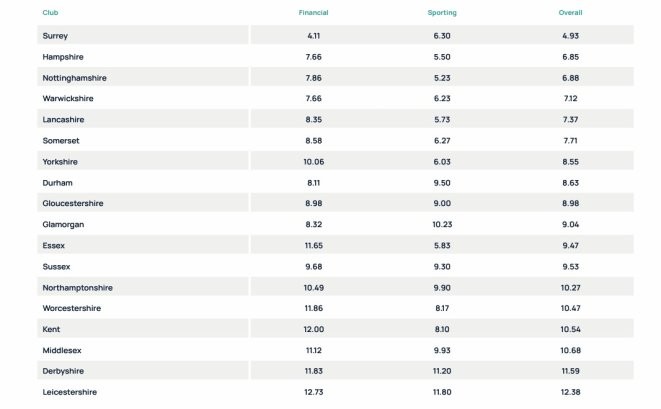17th July 2025
• First-ever Financial Performance Index for the 18 first-class counties has Surrey at the top and highlights a yawning gap between counties who host a Hundred franchise and the non-hosts.
• Surrey, Lancashire and Warwickshire generated 44% (£134.6 million) of the total annual revenue of all counties (£306.1 million) in 2023. These counties can perhaps be seen as the ‘big three’ financially in county cricket.
• Former Ashes-winning England captain Michael Vaughan, who wrote the report’s foreword, says: “I believe the smaller counties must spend their windfall on player pathways and getting their facilities up to scratch.”
The financial health of domestic cricket in England and Wales has been examined in a new report from Leonard Curtis, which includes a first-ever Financial Performance Index for the 18 first-class counties.
The Leonard Curtis Cricket Finance Report has been published as the sport stands on the cusp of a £520 million investment from the sale of equity in The Hundred’s eight franchises.
The Index is built on a robust and widely respected methodology developed by some of the world’s leading sports finance academics, and the report has been produced by a team of sports business journalists, former and current cricket professionals, advisers and sports finance academics.
The report was launched at an event at The Kia Oval on July 15th, where former Ashes-winning England captain Michael Vaughan – who wrote the report’s foreword – shared his views on the state of county cricket and what the windfall from The Hundred could do for the game.
“The Hundred money allows the 18 first-class counties to look to the future rather than simply survive from one summer to the next,” he said, adding: “I believe the smaller counties must spend their windfall on player pathways and getting their facilities up to scratch.”
He also called for all counties to work together and share ideas about how the new investment can boost the game. “There needs to be a strategic plan of how to create a sustainable county cricket club,” he said.
“I would like to see counties being transparent with each other and sharing knowledge about what works for them. Sometimes petty rivalries prevent that from happening and divisions between the Test host counties and the others develop.”
Yawning gap between host counties and non-hosts
The data included in the report highlights the yawning gap in financial strength between counties who host a Hundred franchise and non-hosts.
The new Financial Performance Index – which ranks clubs based on their results on and off the field from 2014 to 2023 (the last ten years where financial data from all counties is available) – reveals that Surrey was by some distance the best performing club overall in county cricket across financial and sporting performance over this period. (A lower score in the Index is desirable, as explained in the Notes to editors below).
Surrey – who host the Oval Invincibles in The Hundred – have a score of 4.93, which is two-and-a-half times superior to that of non-host Leicestershire, the lowest ranked county on 12.38.
The seven host counties all feature in the top ten of the Financial Performance Index, and the average score of those counties is 7.25, compared with 9.07 for the non-hosts.
Alongside the Index, the report provides detailed analysis of counties’ revenue, total wages, profit/loss, debt and equity positions over the last ten years.
Key findings include:
• The ‘big three’
Surrey, Lancashire and Warwickshire generated 44% (£134.6 million) of the total annual revenue of all counties (£306.1 million) in 2023. These three counties can perhaps be seen as the ‘big three’ financially in county cricket.
• Reliance on central funding
Several counties lower down the Index rely on distributions from the England and Wales Cricket Board (ECB) for most of their income. In 2023, while for Surrey this accounted for 6% of their income, 10% for Warwickshire and 14% for Lancashire, for Derbyshire it was 56%, Leicestershire 67% and Northamptonshire 71%.
Cricket Financial Performance Index: The rankings for 2014 to 2023

Need for long-term commercial strategies
The report concludes that while The Hundred investment offers a short-to-medium term revenue boost, it cannot support the county model indefinitely. Counties will need to develop long-term commercial strategies that extend beyond this windfall, or risk further polarisation between the ‘haves’ and ‘have nots’.
Prof Rob Wilson, who is a Professor of Applied Sport Finance and co-author of the Leonard Curtis Cricket Finance Report, said: “This report raises questions about the long-term viability of the county model. Investment in The Hundred may provide some medium-term relief, but only if invested strategically and to build infrastructure.
“Cricket in England and Wales remains overly reliant on central distributions, TV rights, and international fixtures at a handful of Test grounds. While significant profits have been posted in isolated cases over the past ten years, they are exceptions to the rule. Without ECB support and income from The Hundred, it is questionable whether some counties could survive even for a single season.”
The report also analyses new developments in women’s cricket and disability cricket, as well as how counties can use The Hundred windfall to invest in environmental sustainability initiatives.
Competitive balance
In addition, new research included in the report suggests there are signs of a decline in competitive balance in county cricket, particularly in the 50-over One-Day Cup.
Analysis using HICB, an academic metric which measures competitive balance in sporting leagues over time, found that over the last four seasons (between 2021 and 2024), when all group stage matches in the One-Day Cup were played alongside The Hundred, average competitive balance dropped by 14.09%, from 69.17 between 2014 and 2019 to 59.42 between 2021 and 2024.
Recommendations
A series of recommendations for the use of The Hundred investment in the report include:
• Maintain cash reserves and carry out strategic spending to help ensure financial sustainability – but not at the expense of cricket operations and success on the field
• Adopt financial prudence over the long-term, with careful management of any sudden influx of money
• Balance short-term gains with future stability
• Resist the temptation to make flashy but unsustainable investments
• Manage stakeholder expectations – including any pressure from players, staff and agents for higher salaries and benefits.
David Brown, Chief Operating Officer at Leonard Curtis and a former professional cricketer with Gloucestershire and Glamorgan, said: “The new investment into The Hundred has presented the county game with a great opportunity to tackle its challenges, but it must be administered sensibly to solve problems and drive financial sustainability for the long term.”
He added: “This can not only ensure that counties thrive, but the recreational game can too. I believe the strength of the sport in this country is dependent on a strong pyramid. I benefitted from this, learning my cricket at my local club but also being a graduate of the Durham University Centre of Cricketing Excellence (UCCE).”
New opportunities for women’s cricket
The report also comes at a pivotal time for women’s cricket in England and Wales, with a new professional structure introduced this summer featuring teams connected to each of the 18 first-class counties.
Gessica Howarth, Vice-President and a founding member of Sphera Partners, a growth equity investment firm focused on women’s sport, was on the expert panel which contributed to the report.
She said: “Women’s cricket now stands at a unique inflection point. The introduction of the new domestic structure presents a significant opportunity to unlock and engage an emerging fanbase, while harnessing the scale and support of the established men’s county system.
“It can also help the game capitalise on the momentum building across the sport, particularly since the launch of The Hundred, which has powerfully demonstrated demand for the women’s game.”
Time for The Hundred to adopt disability cricket
Another aspect of the game at a key point in its development is disability cricket. Iain Nairn MBE, a Leonard Curtis director and former T20 World Series-winning England Physical Disability cricket captain, called for this form of the game to be included within The Hundred to help boost its profile and grow participation.
He said: “Key to disability cricket’s development will be linking it into The Hundred as it continues to develop and attract players, fans and volunteers to the game. The ECB needs to ensure that, through its funding formula, all counties can provide opportunity for disabled cricketers to participate on both a grassroots and elite level. The Hundred appears to be a great format to drive fresh engagement.”
For more information or to download the full report, visit Cricket Finance Report 2025


